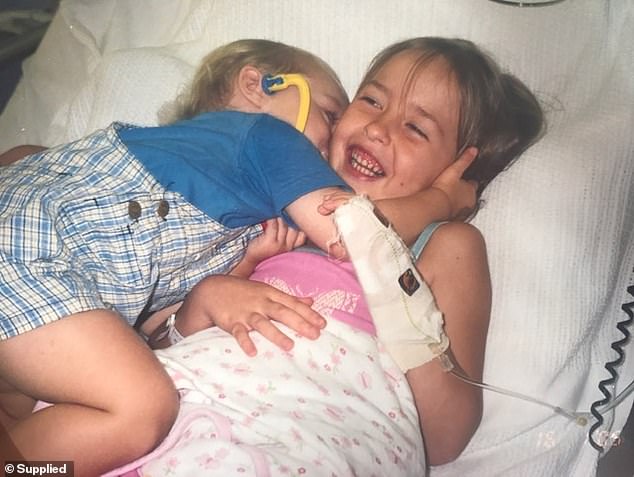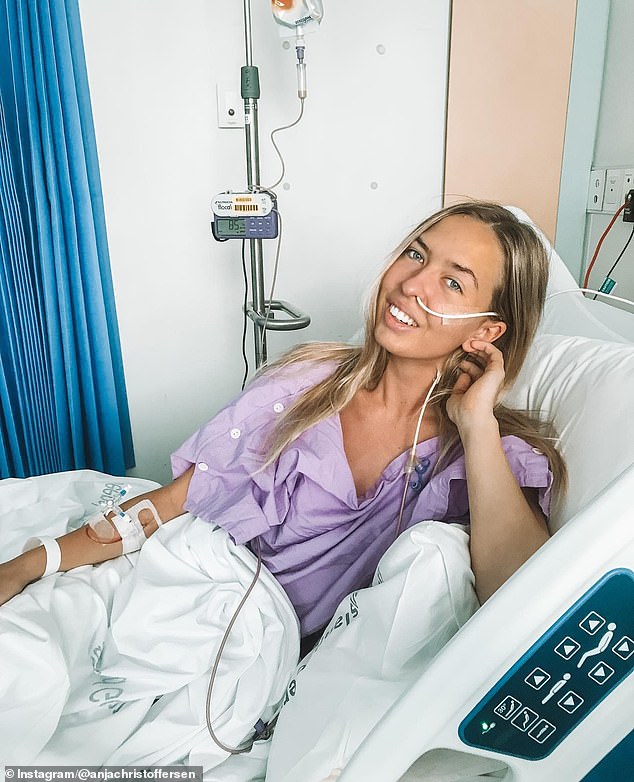I was born with two vaginas thanks to ultra-rare genetic condition…here’s how I live as normally as possible
A young woman born without a crucial part of her digestive and urinary systems has described the medical ordeal that plagued her young life.
Model Anja Christoffersen, now 25, suffers from a congenital condition the urinary, genital and digestive tracts join together, leaving a single opening in the pelvis where there should be three.
The deformity called cloaca affects one in 50,000 girls, and means women like Anja are born with two vaginal canals and two uteruses, despite the unusual opening.
In a series of TikTok clips, the young woman describes the devastating toll the condition has had on her body; including 25 operations and lifelong problems with incontinence, urinary tract infections and pneumonia.
The 25-year-old Australian model was born without an anus and two vaginal canals and uteruses


She has detailed her condition on TikTok
“I grew up believing that I could do whatever I set my mind to, despite my congenital condition,” she says in her book videoadding that her grandmother and mother told her at a young age that the disease did not define her.
‘It doesn’t have to have an impact on your quality of life and the dreams you can achieve.’
Ms Christoffersen is now a fashion model and walks the catwalks during Amsterdam Fashion Week. She also advocates for other people suffering from the congenital condition.
When a fetus develops, the only canal for the genitals, the digestive tract and the urinary tract, are separated.
But in cloaca, this separation process does not take place, creating a single opening for the passage of waste.
Her first surgery was performed almost immediately after birth, during which doctors performed a colostomy and vesicostomy to create openings in the abdominal wall to allow the passage of stool and urine.
When she was seven months old, doctors operated on her pelvis, making an incision all the way down to her spine to separate the three canals and create the standard three holes.
Since then, she has undergone approximately 24 additional surgeries, including operations to reconstruct the pelvis and to address abdominal problems.
And urinary and bowel incontinence is an ongoing battle, because she has no natural muscles in her rectum or anus.
Ms Christoffersen was also born with an underdeveloped esophagus, meaning food could not reach her stomach. An abnormal connection between the trachea and the esophagus could allow food to enter the airways. All this was repaired at birth.
She said: ‘When I was younger I was in and out of hospital with chest and urinary tract infections, chronic constipation because I don’t have natural bowel contractions, further medical imaging, treatment and surgery.

When she was seven months old, doctors operated on her pelvis, making an incision from the front to her spine, creating the standard three holes.

Since then, she has undergone 24 operations
‘When I was one year old, I started performing rectal rinses daily [enemas] to induce intestinal contractions and give me social continence. Otherwise my intestine was like a faucet that was open and constantly or completely closed and became clogged. Even with these washes, I would still have accidents in everyday life.
She also deals with chronic pain and other ongoing problems related to her intestines, reproductive system and urinary tract.
Doctors aren’t sure what causes the cloacal anomaly, but it is believed to occur randomly.
Cloacal abnormalities can cause incontinence and a predisposition to urinary tract infections.
They can also lead to constipation, intestinal obstruction and spinal abnormalities. Cloacal abnormalities can also cause urine to flow back into the kidneys, which can lead to damage.
The disease can be detected during pregnancy through ultrasound, as in Ms. Christoffersen’s case, but is usually diagnosed when the baby is born.
She said: ‘I was lucky to be diagnosed early so the doctors could prepare for my arrival. They were unsure of the severity of my condition, but still managed to put together a good team to prepare for my birth.’
The condition has been likened to having a doll’s pelvis by Allison Wadsworth, whose eight-year-old daughter was also born without an anus or vagina.
Mrs Wadsworth said: ‘She was like a doll. She had a girl’s line and then nothing. Just clear, smooth skin.”
